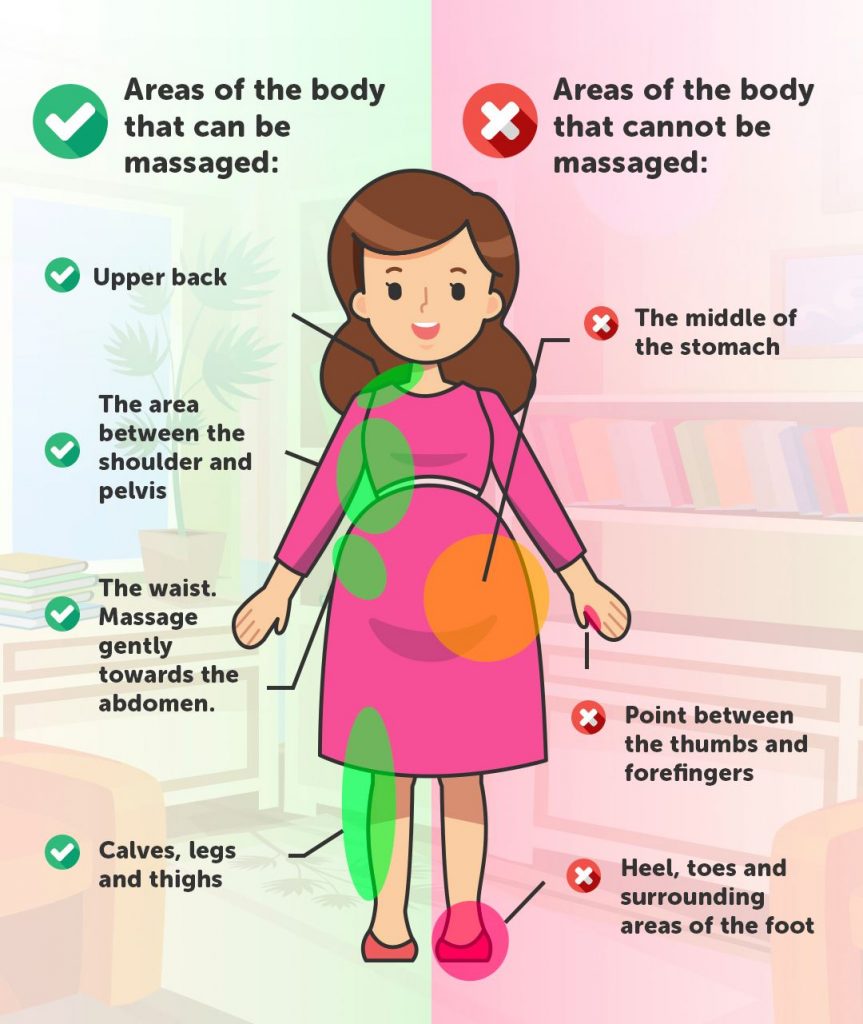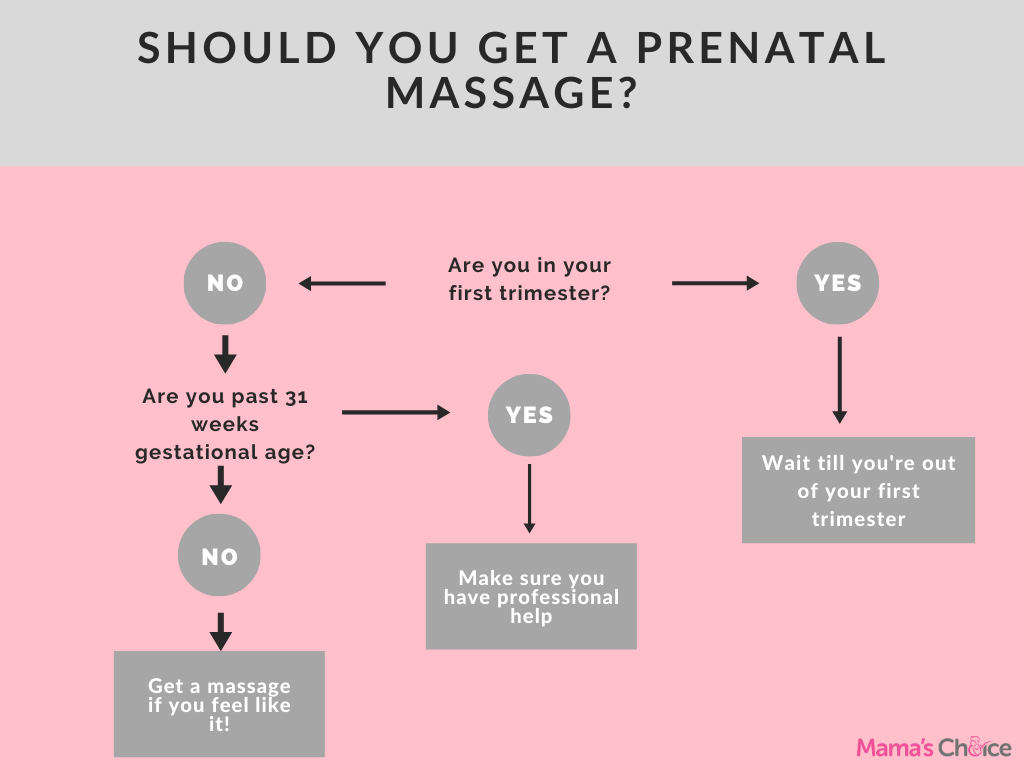Did you know that prenatal massage is very beneficial during your pregnancy? They can help to ease back pain and relieve stress.
Fun fact: Most women experience lower back pain between the 20th and 28th weeks of pregnancy. While we recommend that you try walking, exercising and improving your posture to reduce muscle aches, it doesn’t always help.
You should definitely try a prenatal massage during your pregnancy. It’s possible to do it at home, but you need to be careful. Follow our guide to make sure that you do it safely!
What are the differences between prenatal massages and normal massages?
Prenatal massages are massages that are safe for pregnancy. Massage techniques are basically the same as a regular massage, but the pressure is softer and restricted to certain points.
As you can see, it’s not as different as you might expect!
Use this infographic to help you remember which areas you can massage during pregnancy!
And if you find it helpful – leave a comment below! At Mama’s Choice, we’re committed to making safe pregnancy decisions accessible to all. Letting us know where we can improve helps us make our content better for all mums 🙂
When is the best time to get a prenatal massage?
Technically, according to most other sources, you can get a prenatal massage any time you like after the first trimester. We don’t necessarily agree – If you’re doing a prenatal massage at home, the best window is between 12 – 31 weeks of pregnancy.
Here’s why.
Your pregnancy is the most fragile during the first trimester (12 weeks). During this period, a mistake could easily lead to miscarriage. In fact, most professional therapists will refuse to give you a prenatal massage if you’re still in the first trimester!
Past 12 weeks, the fetal position is generally more stable, so it’s safe to do light massages to help blood flow throughout the body and to the fetus.
We don’t recommend getting a prenatal massage done at home after 31 weeks gestational age, especially if there isn’t someone experienced to help you out. As you approach delivery (and becoming a new mum!), certain massage points can trigger contractions. If you must get a massage, make sure you consult a professional or a doctor first.
Here’s a simple infographic for you if you don’t want to read too much!
3 simple steps for a prenatal massage at home
A pregnancy massage by your partner releases oxytocin (the love hormone), which makes you healthier and happier!
Chances are, though, your partner isn’t a therapist experienced in prenatal massage. (If they are, congratulations! You’re going to have an incredibly relaxing pregnancy! )
Don’t worry, you can still “oblige“ them to help you out. Just make sure that they massage lightly and point out the areas where it’s definitely safe to massage (Refer to our infographic above!)
Here are the steps you should take for a DIY massage.
Step 1
Firstly, get a pillow to support your stomach. This applies for any position. There are two commonly-used positions for massage during pregnancy: Sitting and lying on your side.
When sitting, face the wall or the back of a chair with a pillow placed on your stomach for support.
When lying sideways, use a pillow to support the stomach so that the position remains comfortable and safe.
Step 2
Now your partner can start massaging! Remember to use light movements on areas that are safe (Refer to our infographic above).
Be especially careful around the abdomen. Soothe the body with light strokes so that your baby can feel the massage. A prenatal massage is simple! It generally takes between 5-10 minutes, and can improve you and your baby’s health.
Step 3
The third step is to use a prenatal massage oil to help make the massage softer, gentler and more relaxing. Using massage oil makes the surface of the skin more slippery, allowing you to control pressure better.
Note: Make sure to choose massage oils that are safe for pregnancy, as not all essential oils are safe for pregnant women. We recommend you to go for Mama’s Choice Relaxing Massage Oil as it is 100% made with all-natural, Halal and safe ingredients just for mums! You can find it on our official Shopee and Lazada.
Benefits of getting a massage during pregnancy
Here are some key benefits of prenatal massage that you might find interesting.
- Smoother blood circulation. Massages help ensure a smooth supply of blood and nutrients to the fetus. By improving circulation, they can also reduce swelling.
- Stabilised hormones. Again, this is a benefit of improved circulation. Prenatal massages can help better prepare you for delivery.
- Reduced blood pressure. By balancing your heart rate and blood pressure, prenatal massages can help ease your labour process.
- Better mental well-being. Massages make the body feel more relaxed, which naturally stimulates oxytocin. You’ll start feeling happier, more alert and less stressed.
- Reduced muscle and joint pain. It’s a very good method of easing your pregnancy back pain!
- Better sleep. Massage reduces cortisol (stress hormones). You’ll be less likely to feel anxiety, which helps you get the beautiful, vital rest you need. That is, until your baby arrives, when you’ll have to deal with 3-6 months of feeding them every 2-3 hours before they finally sleep through the night.
Important reminders for DIY prenatal massage
Prenatal massage definitely isn’t a “don’t try this at home” activity. But to some, it can be quite challenging. It’s important to understand the limits of prenatal massage, especially when you’re trying it at home.
- If you’re trying to deal with ailments such as muscle aches, consider engaging a therapist who is experienced with prenatal massage. It will probably be somewhat safer, and more effective. Alternatively, you could visit a spa or massage parlour that caters to pregnant women.
- Don’t combine your massage with treatments that use heat, such as: Hot water, steam baths, jacuzzis or saunas.
- Consult your obstetrician before making any decisions. They could have some additional pointers for you!
Conclusion
Prenatal massage is useful, and it’s convenient. It can be as simple as a short 5-10 minute massage to help ease your stress. If you want a full-body relaxation experience, engaging an expert prenatal masseuse to help you is also a great option!
If you found this guide useful, or if you’ve got any questions or recommendations, leave a comment below or drop us a DM on our Instagram ! We read all your suggestions 🙂
Raymond Santosa
















